MSI K9A2GM, K9A2VM, MS-7501 User Manual
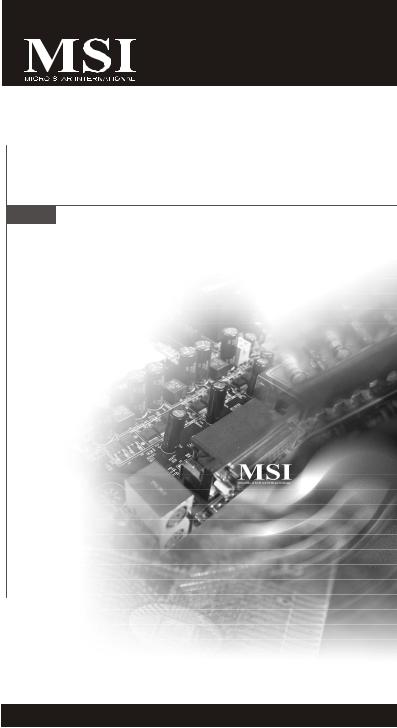
K9A2GM / K9A2VM
MS-7501 (V1.X) Mainboard
G52-75011X7
i

Copyright Notice
The material in this document is the intellectual property of M ICRO-STAR INTERNATIONAL. We take every care in the preparation of this document, but no guarantee is given as to the correctness of its contents. Our products are under continual improvement and we reserve the right to make changes without notice.
Trademarks
All trademarks are the properties of their respective owners.
NVIDIA, the NVIDIA logo, DualNet, and nForce are registered trademarks or trademarks of NVIDIA Corporation in the United States and/or other countries.
AMD, Athlon™, Athlon™ XP, Thoroughbred™, and Duron™ are registered trademarks of AMD Corporation.
Intel® and Pentium® are registered trademarks of Intel Corporation.
PS/2 and OS®/2 are registered trademarks of International Business Machines Corporation.
Windows® 2000/NT/XP/Vista are registered trademarks of Microsoft Corporation. Netware® is a registered trademark of Novell, Inc.
Award® is a registered trademark of Phoenix Technologies Ltd. AMI® is a registered trademark of American Megatrends Inc.
Revision History
Revision |
Revision History |
Date |
V1.0 |
First release |
August 2008 |
Technical Support
If a problem arises with your system and no solution can be obtained from the user’s manual, please contact your place of purchase or local distributor. Alternatively, please try the following help resources for further guidance.
 Visit the MSI website for FAQ, technical guide, BIOS updates, driver updates, and other inf ormation: ht tp://global.msi.com.tw/index.php? func=service
Visit the MSI website for FAQ, technical guide, BIOS updates, driver updates, and other inf ormation: ht tp://global.msi.com.tw/index.php? func=service
 Contact our technical staff at: http://ocss.msi.com.tw
Contact our technical staff at: http://ocss.msi.com.tw
ii

Safety Instructions
1.Always read the safety instructions carefully.
2.Keep this User’s Manual for future reference.
3.Keep this equipment away from humidity.
4.Lay this equipment on a reliable flat surface before setting it up.
5.The openings on the enclosure are for air convection hence protects the equipment from overheating. DO NOT COVER THE OPENINGS.
6.Make sure the voltage of the power source and adjust properly 110/220V before connecting the equipment to the power inlet.
7.Place the power cord such a way that people can not step on it. Do not place anything over the power cord.
8.Always Unplug the Power Cord before inserting any add-on card or module.
9.All cautions and warnings on the equipment should be noted.
10.Never pour any liquid into the opening that could damage or cause electrical shock.
11.If any of the following situations arises, get the equipment checked by service personnel:
†The power cord or plug is damaged.
†Liquid has penetrated into the equipment.
†The equipment has been exposed to moisture.
†The equipment does not work well or you can not get it work according to User’s Manual.
†The equipment has dropped and damaged.
†The equipment has obvious sign of breakage.
12.DONOT LEAVETHIS EQUIPMENT INANENVIRONMENT UNCONDITIONED, STORAGE TEMPERATURE ABOVE 600 C (1400F), IT MAYDAMAGE THE EQUIPMENT.
CAUTION: Danger of explosion if battery is incorrectly replaced. Replace only with the same or equivalent type recommended by the manufacturer.
iii

FCC-B Radio Frequency Interference Statement
This equipment has been tested and found to comply with the limits for a Class B digital device, pursuant to Part
15 of the FCC Rules. These limits are designed to provide reasonable protection against harmful interference in a residential installation. This equipment generates, uses and can radiate radio frequency energy and, if not installed and used in accordance with the instructions, may cause harmful interference to radio communications. However, there is no guarantee that interference will not occur in a particular installation. If this equipment does cause harmful interference to radio or television reception, which can be determined by turning the equipment off and on, the user is encouraged to try to correct the interference by one or more of the measures listed below.
†Reorient or relocate the receiving antenna.
†Increase the separation between the equipment and receiver.
†Connect the equipment into an outlet on a circuit different from that to which the receiver is connected.
†Consult the dealer or an experienced radio/television technician for help.
Notice 1
The changes or modifications not expressly approved by the party responsible for compliance could void the user’s authority to operate the equipment.
Notice 2
Shielded interface cables and A.C. power cord, if any, must be used in order to comply with the emission limits.
VOIR LANOTICE D’INSTALLATIONAVANT DE RACCORDER AU RESEAU.
Micro-Star International
MS-7501
This device complies with Part 15 of the FCC Rules. Operation is subject to the following two conditions:
(1)this device may not cause harmful interference, and
(2)this device must accept any interference received, including interference that may cause undesired operation.
iv

WEEE (Waste Electrical and Electronic Equipment) Statement
v

vi

vii
|
CONTENTS |
|
Copyright |
Notice ......................................................................................................... |
ii |
Trademarks .................................................................................................................. |
ii |
|
Revision |
History ......................................................................................................... |
ii |
Technical |
Support ...................................................................................................... |
ii |
Safety Instructions ................................................................................................... |
iii |
|
FCC-B Radio Frequency Interference Statement ............................................. |
iv |
|
WEEE (Waste Electrical and Electronic Equipment) Statement ....................... |
v |
|
English ...................................................................................................................... |
|
En-1 |
Specifications .................................................................................................... |
En-2 |
|
Central Processing Unit: CPU ........................................................................... |
En-5 |
|
Memory............................................................................................................... |
En-7 |
|
Back Panel .......................................................................................................... |
En-9 |
|
Connectors, Jumpers, Slots ............................................................................ |
En-11 |
|
BIOS Setup ....................................................................................................... |
En-18 |
|
Software Information ...................................................................................... |
En-22 |
|
Deutsch .................................................................................................................... |
|
De-1 |
Spezifikationen .................................................................................................. |
De-2 |
|
Hauptprozessor: CPU ....................................................................................... |
De-5 |
|
Speicher ............................................................................................................. |
De-7 |
|
Hinteres Anschlusspaneel ............................................................................... |
De-9 |
|
Anschlüsse, Steckbrücken und Slots ........................................................... |
De-11 |
|
BIOS Setup ....................................................................................................... |
De-18 |
|
Software-Information ...................................................................................... |
De-22 |
|
Français ..................................................................................................................... |
|
Fr-1 |
Spécificités ......................................................................................................... |
Fr-2 |
|
Central Processing Unit: CPU ............................................................................ |
Fr-5 |
|
Mémoire ............................................................................................................... |
Fr-7 |
|
Panneau Arrière ................................................................................................. |
Fr-9 |
|
Connecteurs, Cavaliers, Slots ........................................................................ |
Fr-11 |
|
Configuration du BIOS ...................................................................................... |
Fr-18 |
|
Information de Logiciel ..................................................................................... |
Fr-22 |
|
Русский .................................................................................................................... |
|
Ru-1 |
Характеристики ............................................................................................... |
Ru-2 |
|
Центральный процессор (CPU) ..................................................................... |
Ru-5 |
|
Память .............................................................................................................. |
Ru-7 |
|
Задняя панель ................................................................................................. |
Ru-9 |
|
Коннекторы, перемычки, разъемы ............................................................ |
Ru-11 |
|
Настройка BIOS .............................................................................................. |
Ru-18 |
|
Сведения о программном обеспечении ................................................... |
Ru-22 |
|
viii

English
K9A2GM / K9A2VM
User’s Guide
English
En-1
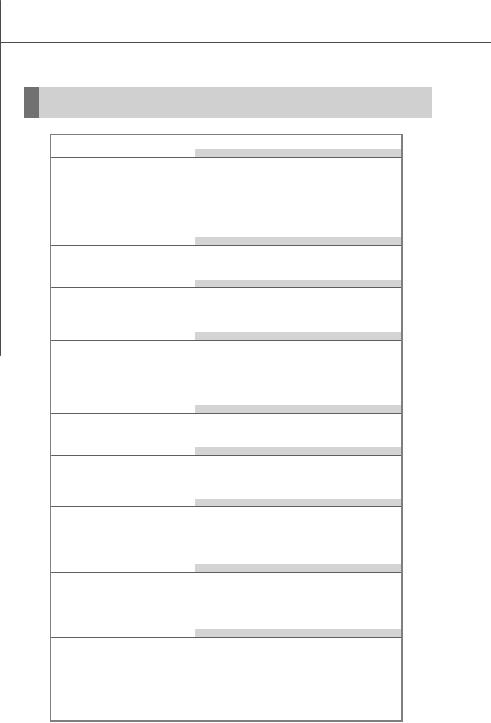
 MS-7501 Mainboard
MS-7501 Mainboard
Specifications
 Processor
Processor
-Supports AMD Phenom / Athlon 64 / Sempron processors
-Supports 4-pin CPU fan pinheader with Fan Speed Control
-Supports up to 5000+ and above
(For the latest information about CPU, please visit http://global.msi.com.tw/index.php?func=cpuform)
 FSB
FSB
- Hyper Transport supports up to 2.6GHz
 Chipset
Chipset
-North Bridge: AMD 780G / 780V
-South Bridge: AMD SB700
 M emory
M emory
-DDR2 533/667/800/1066 SDRAM (240 pins / 1.8V)
-4 DDR2 DIMM slots (8GB Max)
(For more information on compatible components, please visit http://global.msi.com.tw/index.php?func=testreport)
 LAN
LAN
- Gigabit Fast Ethernet by Realtek RTL8111C
 IEEE 1394 (Optional)
IEEE 1394 (Optional)
-Chip integrated by JMicron 381
-Transfer rate is up to 400Mb/s
 Audio
Audio
-Chip integrated by Realtek ALC888
-Flexible 8-channel audio with jack sensing
-Compliant with Azalia 1.0 Spec
 IDE
IDE
-1 IDE port by SB700
-Supports Ultra DMA 33/66/100/133 mode
-Supports PIO, Bus Master operation mode
 SATA
SATA
-4 SATA II ports by SB700
-Supports 4 SATA II devices
-Supports storage and data transfers at up to 3Gb/s
En-2

Floppy
-1 floppy port
-Supports 1 FDD with 360KB, 720KB, 1.2MB, 1.44MB and 2.88MB
Connectors
 Back Panel
Back Panel
-1 PS/2 mouse port
-1 PS/2 keyboard port
-1 IEEE 1394 port (Optional)
-4 USB 2.0 ports
-1 Gigabit LAN jack
-1 VGA port
-1 DVI port (Optional)
-1 HDMI port (Optional)
-6 flexible audio jacks
 Onboard Connectors
Onboard Connectors
-3 USB 2.0 connectors
-1 IEEE 1394 connector (Optional)
-1 TPM connector (Optional)
-1 serial port connector
-1 CD-In connector
-1 SPDIF-Out connector
-1 chassis intrusion switch pinheader
-1 front panel audio connector
Slots
-1 PCI Express x16 slot
-1 PCI Express x1 slot
-2 32-bit/33MHz PCI slots
Form Factor
- M-ATX (24.4cm X 24.4 cm)
Mounting
- 6 mounting holes
English
En-3
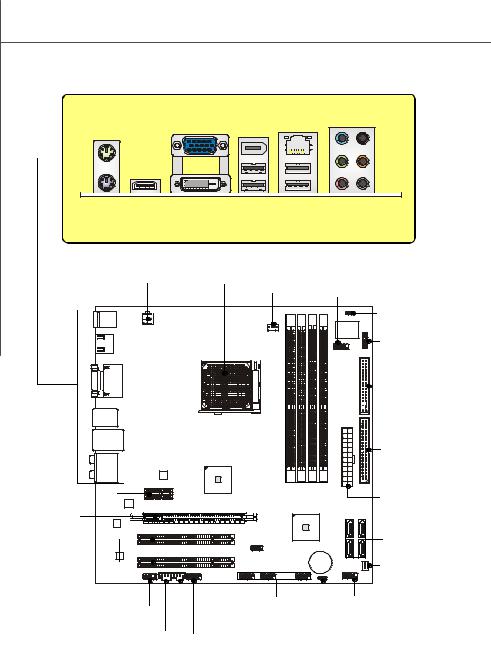
 MS-7501 Mainboard
MS-7501 Mainboard
|
|
|
IEEE 1394 |
|
|
Mouse, p. En-9 |
VGA, p. En-9 |
(Optional), |
LAN, p. En-10 |
||
|
|
p. En-9 |
|
|
|
HDMI |
|
|
|
|
|
(Optional), |
|
|
|
|
|
p. En-9 |
|
|
|
|
|
Keyboard, |
|
DVI-D |
USB Ports, p. En-10 |
Audio Jacks, |
|
p. En-9 |
|
(Optional), |
|
|
p. En-10 |
|
|
p. En-9 |
|
|
|
PWR1, p. En-11 |
|
|
DIMM Slots, p. En-7 |
||
CPU, p. En-5 |
|
|
|||
|
|
|
CPUFAN1, p. En-12 |
JCOM1, p. En-14 |
|
|
|
|
|
|
|
|
|
|
|
|
JCI1, p. En-14 |
|
|
|
|
|
JTPM1, |
|
|
|
|
|
p. En-15 |
F D D 1 , |
p. En-12 |
IDE1, |
p. En-12 |
|
|
|
ATXPWR1, |
PCI Express |
|
|
p. En-11 |
|
|
|
|
Slots, |
|
|
|
p. En-17 |
|
|
SATA1~4, |
|
|
|
p. En-13 |
PCI Slots, |
|
|
SYSFAN1, |
p. En-17 |
|
|
|
|
|
p. En-12 |
|
|
|
|
|
JAUD1, p. En-15 |
JUSB1~3, |
JBAT1, |
JFP1, p. En-13 |
p. En-14 |
p. En-16 |
|
JCD1, p. En-15 J1394_1, p. En-13
SPDOUT1, p. En-15
K9A2GM / K9A2VM (MS-7501 v1.X)
Micro-ATX Mainboard
En-4
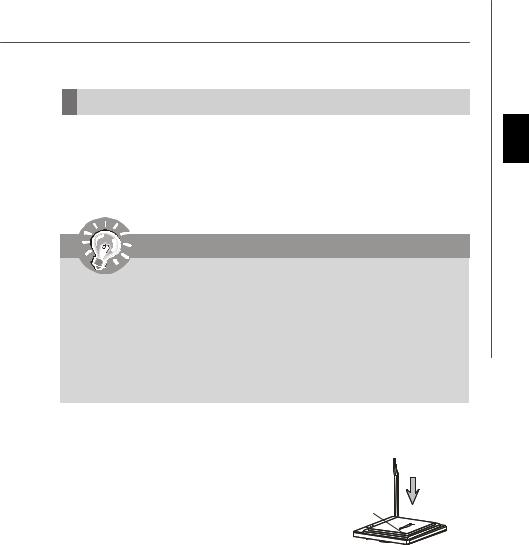
Central Processing Unit: CPU
The mainboard supports AMD® processor. The mainboard uses a CPU socket called Socket AM2/AM2+ for easy CPU installation. If you do not have the CPU cooler, consult your dealer before turning on the computer.
For the latest information about CPU, please visit http://global.msi.com.tw/index.php? func=cpuform
Important
Overheating
Overheating will seriously damage the CPU and system. Always make sure the cooling fan can work properly to protect the CPU from overheating. Make sure that you apply an even layer of thermal paste (or thermal tape) between the CPU and the heatsink to enhance heat dissipation.
Replacing the CPU
While replacing the CPU, always turn off the ATX power supply or unplug the power supply’s power cord from the grounded outlet first to ensure the safety of CPU.
CPU Installation Procedures for Socket AM2/ AM2+
1. Please turn off the power and unplug the power cord before installing the CPU.
2. Pull the lever sideways away from the socket. Make sure to raise the lever up to a 90-degree angle.
3. Look for the gold arrow of the CPU. The gold arrow should
point as shown in the picture. The CPU can only fit in the 












 correct orientation.
correct orientation. 




















4. If the CPU is correctly installed, the pins should be com-
pletely embedded into the socket and can not be seen. Please note that any violation of the correct installation procedures may cause permanent damages to your mainboard.
5.Press the CPU down firmly into the socket and close the lever. As the CPU is likely to move while the lever is being closed, always close the lever with your fingers pressing tightly on top of the CPU to make sure the CPU is properly and completely embedded into the socket.
English
En-5
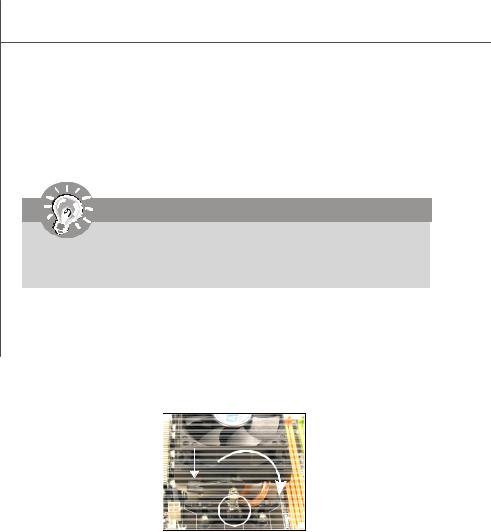
 MS-7501 Mainboard
MS-7501 Mainboard
Installing CPU Cooler Set
When you are installing the CPU, make sure the CPU has a heat sink and a cooling fan attached on the top to prevent overheating. If you do not have the CPU cooler, consult your dealer before turning on the computer.
Important
Mainboard photos shown in this section are for demonstration of the CPU/ cooler installation only. The appearance of your mainboard may vary depending on the model you purchase.
1.Position the cooling set onto the retention mechanism. Hook one end of the clip to hook first.
2.Then press down the other end of the clip to fasten the cooling set on the top of the retention mechanism. Locate the Fix Lever and lift up it .
3.Fasten down the lever.
4.Attach the CPU Fan cable to the CPU fan connector on the mainboard.
Fixed Lever
En-6
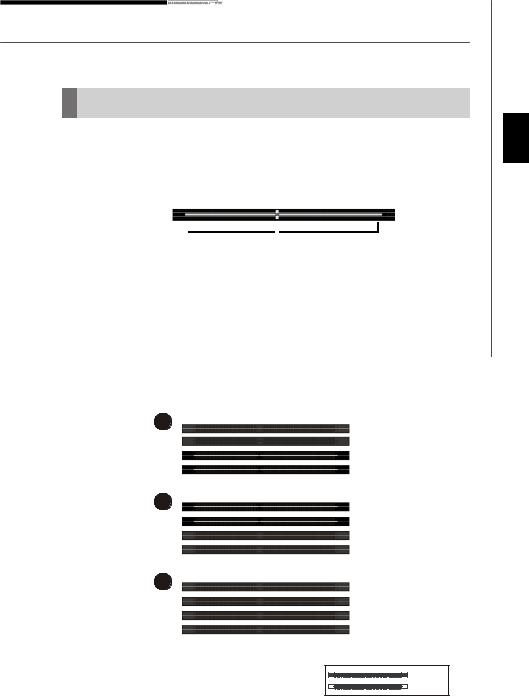
Memory
These DIMM slots are used for installing memory modules.
For more information on compatible components, please visit http://global.msi.com.tw/ index.php?func=testreport
DDR2
240-pin, 1.8V 

 56x2=112 pin 64x2=128 pin
56x2=112 pin 64x2=128 pin
Dual-Channel mode Population Rule
In Dual-Channel mode, the memory modules can transmit and receive data with two data bus lines simultaneously. Enabling Dual-Channel mode can enhance the system performance. Please refer to the following illustrations for population rules under DualChannel mode.
1 |
DIMM1 |
|
|
|
DIMM2 |
|
DIMM3 |
|
DIMM4 |
2 |
DIMM1 |
|
DIMM2 |
|
DIMM3 |
|
DIMM4 |
3 |
DIMM1 |
|
DIMM2 |
|
DIMM3 |
|
DIMM4 |
|
Installed |
|
Empty |
En-7
English
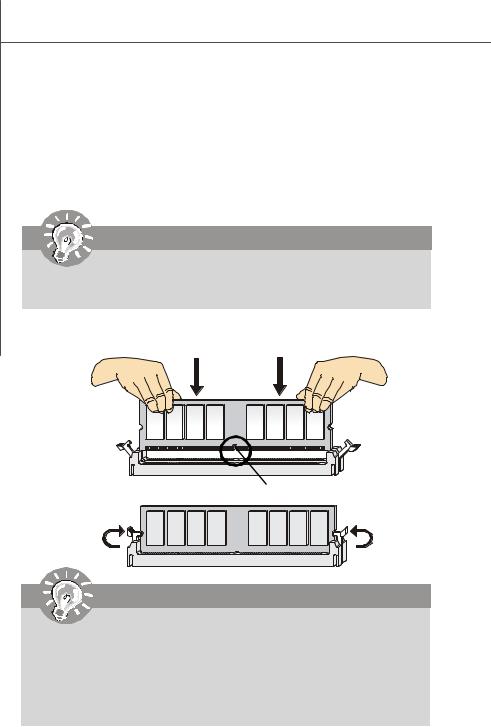
 MS-7501 Mainboard
MS-7501 Mainboard
Installing Memory Modules
1.The memory module has only one notch on the center and will only fit in the right orientation.
2.Insert the memory module vertically into the DIMM slot. Then push it in until the golden finger on the memory module is deeply inserted in the DIMM slot. The plastic clip at each side of the DIMM slot will automatically close when the memory module is properly seated.
Important
You can barely see the golden finger if the memory module is properly inserted in the DIMM slot.
3.Manually check if the memory module has been locked in place by the DIMM slot clips at the sides.
Volt  Notch
Notch
Important
-In Dual-Channel mode, make sure that you install memory modules of the same type and density in different channel DIMM slots.
-To enable successful system boot-up, always insert the memory modules into the DIMM1 first.
-Due to the chipset resource deployment, the system density will only be detected up to 7+GB (not full 8GB) when each DIMM is installed with a 2GB memory module.
En-8
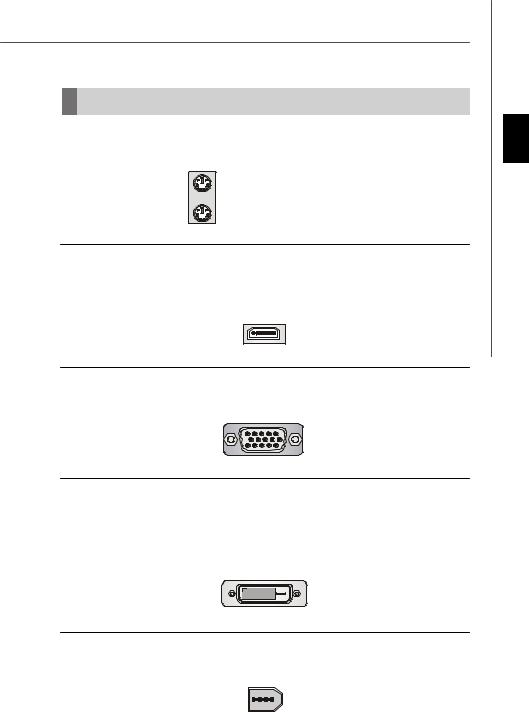
Back Panel
Mouse/Keyboard
The standard PS/2® mouse/keyboard DIN connector is for a PS/2® mouse/keyboard.
PS/2 Mouse connector (Green/ 6-pin female)
PS/2 Keyboard connector (Purple/ 6-pin female)
HDMI Port (Optional)
The High-Definition Multimedia Interface (HDMI) is an all-digital audio/video interface capable of transmitting uncompressed streams. HDMI supports all TV format, including standard, enhanced, or high-definition video, plus multi-channel digital audio on a single cable.
VGA Port
The DB15-pin female connector is provided for monitor.
DVI Port (Optional)
The DVI (Digital Visual Interface) connector allows you to connect an LCD monitor. It provides a high-speed digital interconnection between the computer and its display device. To connect an LCD monitor, simply plug your m onitor cable into the DVI connector, and make sure that the other end of the cable is properly connected to your monitor (refer to your monitor manual for more information.)
IEEE1394 Port (Optional)
The IEEE1394 port on the back panel provides connection to IEEE1394 devices.
En-9
English
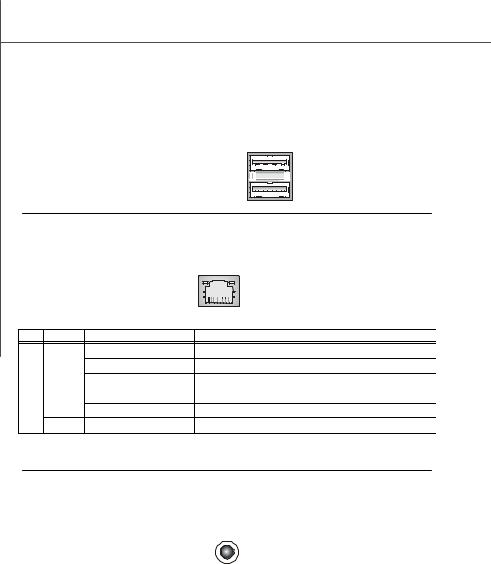
 MS-7501 Mainboard
MS-7501 Mainboard
USB Port
The USB (Universal Serial Bus) port is for attaching USB devices such as keyboard, mouse, or other USB-compatible devices.
LAN
The standard RJ-45 LAN jack is for connection to the Local Area Network (LAN). You can connect a network cable to it.
LED |
Color |
LED State |
Condition |
|
|
Off |
LAN link is not established. |
Left |
Orange |
On (steady state) |
LAN link is established. |
|
|
On (brighter & pulsing) |
The computeriscommunicating with anothercomputeron the LAN. |
|
Green |
Off |
10 Mbit/sec data rate is selected. |
Right |
|
On |
100 Mbit/sec data rate is selected. |
|
Orange |
On |
1000 Mbit/sec data rate is selected. |
Audio Jacks
These audio connectors are used for audio devices. You can differentiate the color of the audio jacks for different audio sound effects.
Line-In (Blue) - Line In, is used for external CD player, tape player or other audio devices.
Line-Out (Green) - Line Out, is a connector for speakers or headphones. MIC (Pink) - Mic In, is a connector for microphones.
RS-Out (Black) - Rear-Surround Out in 4/ 5.1/ 7.1 channel mode. CS-Out (Orange) - Center/ Subwoofer Out in 5.1/ 7.1 channel mode. SS-Out (Gray) - Side-Surround Out 7.1 channel mode.
En-10

Connectors, Jumpers, Slots
Power Supply Attachment
Before inserting the power supply connector, always make sure that all components are installed properly to ensure that no damage will be caused. All power connectors on the mainbnoard have to connect to the ATX power supply and have to work together to ensure stable operation of the mainboard.
ATX 24-Pin Power Connector
This connector allows you to connect an ATX 24-pin power supply. To connect the ATX 24-pin power supply, make sure the plug of the power supply is inserted in the proper orientation and the pins are aligned. Then push down the power supply firmly into the connector.
You may use the 20-pin ATX power supply as you like. If you’d like to use the 20-pin ATX power supply, please plug your power supply along with pin 1 & pin 13.
ATXPWR1
|
12 24 |
+3.3V |
GND |
+12V |
+5V |
+12V |
+5V |
5VSB |
+5V |
PWR OK |
NC |
GND |
GND |
+5V |
GND |
GND |
GND |
+5V |
PS-ON# |
GND |
GND |
+3.3V |
-12V |
+3.3V |
+3.3V |
|
1 13 |
ATX 12V Power Connector
This 12V power connector is used to provide power to the CPU.
PWR1 |
|
3 |
4 |
12V |
12V |
GND |
GND |
1 |
2 |
English
En-11
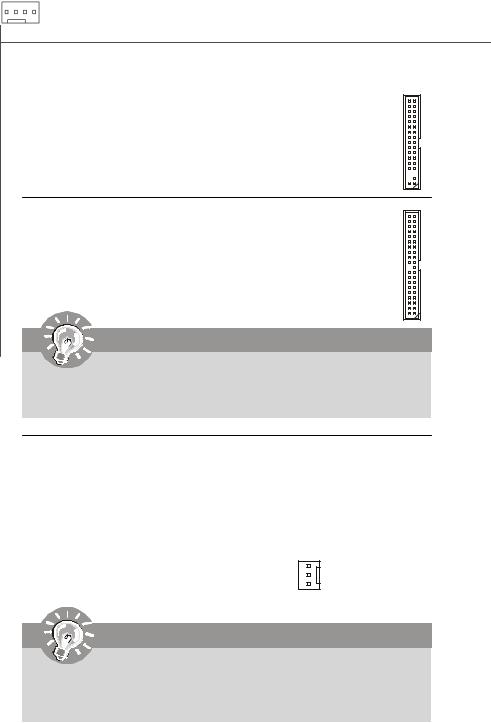
 MS-7501 Mainboard
MS-7501 Mainboard
Floppy Disk Drive Connector
This connector supports 360KB, 720KB, 1.2MB, 1.44MB or 2.88MB floppy disk drive.
FDD1
IDE connector
This connector supports IDE hard disk drives, optical disk drives and other
IDE devices.
IDE1
Important
If you install two IDE devices on the same cable, you must configure the drives separately to Master/ Slave mode by setting jumpers. Refer to IDE device’s documentation supplied by the vendors for jumper setting instructions.
Fan Power Connectors
The fan power connectors support system cooling fan with +12V. The CPU FAN supports Smart FAN function. When connect the wire to the connectors, always take note that the red wire is the positive and should be connected to the +12V, the black wire is Ground and should be connected to GND. If the mainboard has a System Hardware Monitor chipset on-board, you must use a specially designed fan with speed sensor to take advantage of the fan control.
OCES TNSN+G ORO21N LRVD
SENSOR +12V GND
CPUFAN1 SYSFAN1
Important
1.Please refer to the recommended CPU fans at processor’s official website or consult the vendors for proper CPU cooling fan.
2.CPUFAN supports fan control.
3.Fan cooler set with 3 or 4 pins power connector are both available for CPUFAN.
En-12
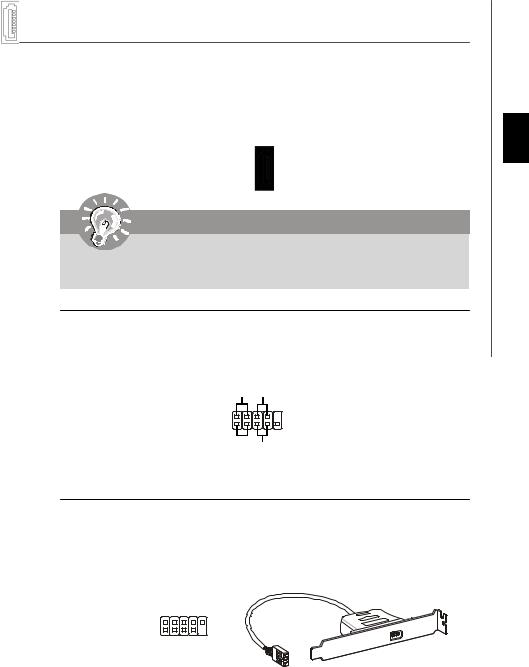
Serial ATA Connector
This connector is a high-speed Serial ATA interface port. Each connector can connect to one Serial ATA device.
Important
Please do not fold the Serial ATA cable into 90-degree angle. Otherwise, data loss may occur during transmission.
Front Panel Connector
This connector is provided for electrical connection to the front panel switches and LEDs and is compliant with Intel® Front Panel I/O Connectivity Design Guide.
Power Power
LED Switch
+ |
- |
2 |
10 |
1 |
9 |
+ - - + HDD Reset
- - + HDD Reset
LED Switch
JFP1
IEEE1394 Connector
This connector allows you to connect the IEEE1394 device via an optional IEEE1394 bracket.
-TPA Ground -TPB Cablepower Ground |
IEEE1394Bracket |
|
|
|
(Optional) |
J1394_1 |
2 |
10 |
|
1 |
9 |
|
|
TPA+ Ground TPB+ Cablepower Key(no pin) |
English
En-13
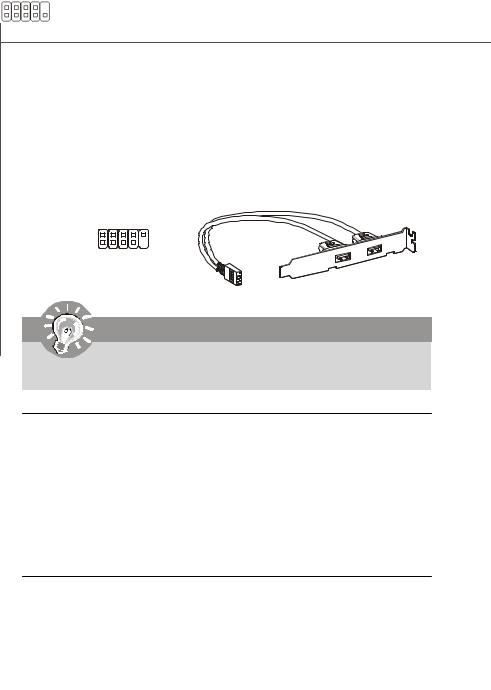
 MS-7501 Mainboard
MS-7501 Mainboard
Front USB Connector
This connector, compliant with Intel® I/O Connectivity Design Guide, is ideal for connecting high-speed USB interface peripherals such as USB HDD, digital cameras, MP3 players, printers, modems and the like.
JUSB1/2/3
VCC USB1- |
USB1+ |
GND USBOC |
2 |
|
10 |
1 |
|
9 |
VCC USB0- |
USB0+ |
GND (no pin) |
|
|
Key |
USB 2.0 Bracket
(Optional)
Important
Note that the pins of VCC and GND must be connected correctly to avoid possible damage.
Chassis Intrusion Connector
This connector connects to the chassis intrusion switch cable. If the chassis is opened, the chassis intrusion mechanism will be activated. The system will record this status and show a warning message on the screen. To clear the warning, you must enter the BIOS utility and clear the record.
1 CINTRU  GND
GND
JCI1
Serial Port Connector
This connector is a 16550A high speed communications port that sends/receives 16 bytes FIFOs. You can attach a serial device to it.
|
SIN DTR DSR CTS |
10 |
|
JCOM1 |
2 |
||
9 |
|||
|
1 |
||
|
DCD SOUT Ground RTS |
RI |
En-14

S/PDIF-Out Connector
This connector is used to connect S/PDIF (Sony & Philips Digital Interconnect Format) interface for digital audio transmission.
SPDOUT1
GND 
 VCC
VCC
SPDIF
CD-In Connector
This connector is provided for external audio input.
L GND R
JCD1
Front Panel Audio Connector
This connector allows you to connect the front panel audio and is compliant with Intel® Front Panel I/O Connectivity Design Guide.
|
Ground NC MIC JD NC(No pin) |
LINE out JD |
JAUD1 |
2 |
10 |
|
1 |
9 |
|
MIC L MIC R LINE out R Front JD |
LINE out L |
TPM module Connector
This connector connects to a TPM (Trusted Platform Module) module (optional). Please refer to the TPM security platform manual for more details and usages.
1413
GND |
LFRAME# |
GND |
LAD3 |
Key(no pin) |
LAD2 |
VCC5 |
LAD1 |
SIRQ |
LAD0 |
VCC3 |
LRST# |
3Vdual / 3V_STB |
LCLK |
|
21 |
JTPM1
English
En-15
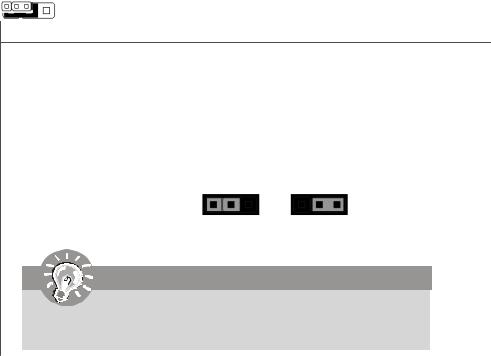
 MS-7501 Mainboard
MS-7501 Mainboard
Clear CMOS Jumper
There is a CMOS RAM onboard that has a power supply from an external battery to keep the data of system configuration. With the CMOS RAM, the system can automatically boot OS every time it is turned on. If you want to clear the system configuration, set the jumper to clear data.
1 |
1 |
3 |
1 |
3 |
JBAT1 |
Keep Data |
|
|
Clear Data |
Important
You can clear CMOS by shorting 2-3 pin while the system is off. Then return to 1- 2 pin position. Avoid clearing the CMOS while the system is on; it will damage the mainboard.
En-16
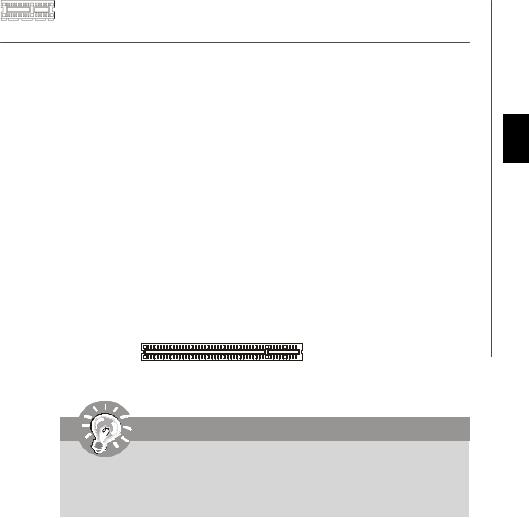
PCI (Peripheral Component Interconnect) Express Slot
The PCI Express slot supports the PCI Express interface expansion card. The PCI Express x 16 slot supports up to 4.0 GB/s transfer rate.
The PCI Express x 1 slot supports up to 250 MB/s transfer rate.
PCI Express x16 Slot
PCI Express x1 Slot
PCI (Peripheral Component Interconnect) Slot
The PCI slot supports LAN card, SCSI card, USB card, and other add-on cards that comply with PCI specifications.
32-bit PCI Slot
Important
When adding or removing expansion cards, make sure that you unplug the power supply first. Meanwhile, read the documentation for the expansion card to configure any necessary hardware or software settings for the expansion card, such as jumpers, switches or BIOS configuration.
English
En-17

 MS-7501 Mainboard
MS-7501 Mainboard
BIOS Setup
This chapter provides basic information on the BIOS Setup program and allows you to configure the system for optimum use. You may need to run the Setup program when:
*An error message appears on the screen during the system booting up, and requests you to run BIOS SETUP.
*You want to change the default settings for customized features.
Important
1.The items under each BIOS category described in this chapter are under continuous update for better system performance. Therefore, the description may be slightly different from the latest BIOS and should be held for reference only.
2.Upon boot-up, the 1st line appearing after the memory count is the BIOS version. It is usually in the format:
A7501AMS V1.0 062508 where:
1st digit refers to BIOS maker as A = AMI, W = AWARD, and P = PHOENIX. 2nd - 5th digit refers to the model number.
6th refers to the Chipset vender as A = ATi, I = Intel, V = VIA, N = Nvidia, U = ULi. 7th - 8th digit refers to the customer as MS = all standard customers.
V1.0 refers to the BIOS version.
062508 refers to the date this BIOS was released.
En-18
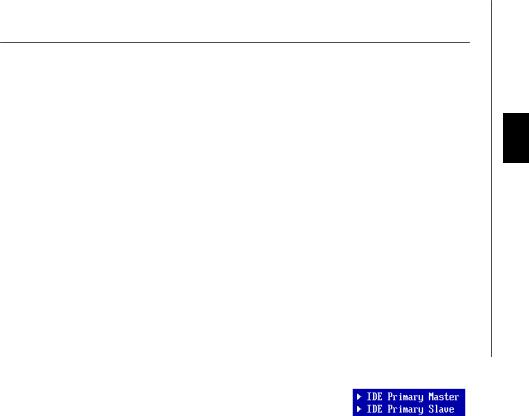
Entering Setup
Power on the computer and the system will start POST (Power On Self Test) process. When the message below appears on the screen, press <DEL> key to enter Setup.
Press DEL to enter SETUP
If the message disappears before you respond and you still wish to enter Setup, restart the system by turning it OFF and On or pressing the RESET button. You may also restart the system by simultaneously pressing <Ctrl>, <Alt>, and <Delete> keys.
Getting Help
After entering the Setup menu, the first menu you will see is the Main Menu.
Main Menu
The main menu lists the setup functions you can make changes to. You can use the arrow keys (↑↓ ) to select the item. The on-line description of the highlighted setup function is displayed at the bottom of the screen.
Sub-Menu
If you find a right pointer symbol (as shown in the right view) appears to the left of certain fields that means a sub-menu containing additional options can be launched from this field. You can use control keys (↑↓ ) to highlight the field and
press <Enter> to call up the sub-menu. Then you can use the control keys to enter values and move from field to field within a sub-menu. If you want to return to the main menu, just press <Esc >.
General Help <F1>
The BIOS setup program provides a General Help screen. You can call up this screen from any menu by simply pressing <F1>. The Help screen lists the appropriate keys to use and the possible selections for the highlighted item. Press <Esc> to exit the Help screen.
English
En-19

 MS-7501 Mainboard
MS-7501 Mainboard
The Main Menu
Once you enter BIOS CMOS Setup Utility, the Main Menu will appear on the screen. The Main Menu allows you to select from ten setup functions and two exit choices. Use arrow keys to select among the items and press <Enter> to accept or enter the sub-menu.
 Standard CMOS Features
Standard CMOS Features
Use this menu for basic system configurations, such as time, date etc.
 Advanced BIOS Features
Advanced BIOS Features
Use this menu to setup the items of AMI® special enhanced features.
 Integrated Peripherals
Integrated Peripherals
Use this menu to specify your settings for integrated peripherals.
 Power Management Setup
Power Management Setup
Use this menu to specify your settings for power management.
 H/W Monitor
H/W Monitor
This entry shows your PC health status.
 Cell Menu
Cell Menu
Use this menu to specify your settings for frequency/voltage control and overclocking.
 Load Fail-Safe Defaults
Load Fail-Safe Defaults
Use this menu to load the default values set by the BIOS vendor for stable system performance.
 Load Optimized Defaults
Load Optimized Defaults
Use this menu to load the default values set by the mainboard manufacturer specifically for optimal performance of the mainboard.
 BIOS Setting Password
BIOS Setting Password
Use this menu to set the password for BIOS.
 Save & Exit Setup
Save & Exit Setup
Save changes to CMOS and exit setup.
 Exit Without Saving
Exit Without Saving
Abandon all changes and exit setup.
En-20

When entering the BIOS Setup utility, follow the processes below for general use.
1.Load Optimized Defaults : Use control keys (↑↓ ) to highlight the Load Optimized Defaults field and press <Enter> , a message as below appears:
Press [Ok] to load the default settings for optimal system performance.
2.Setup Date/ Time : Select the Standard CMOS Features and press <Enter> to enter the Standard CMOS Features-menu. Adjust the Date, Time fields.
3.Save & Exit Setup : Use control keys (↑↓ ) to highlight the Save & Exit Setup field and press <Enter> , a message as below appears:
Press [Ok] to save the configurations and exit BIOS Setup utility.
Important
The configuration above are for general use only. If you need the detailed settings of BIOS, please see the manual in English version on MSI website.
English
En-21
